Beginnings of the Holodeck: AMD's DX11 GPU, Eyefinity and 6 Display Outputs
by Anand Lal Shimpi on September 10, 2009 2:30 PM EST- Posted in
- GPUs
Wanna see what 24.5 million pixels looks like?

That's six Dell 30" displays, each with an individual resolution of 2560 x 1600. The game is World of Warcraft and the man crouched in front of the setup is Carrell Killebrew, his name may sound familiar.
Driving all of this is AMD's next-generation GPU, which will be announced later this month. I didn't leave out any letters, there's a single GPU driving all of these panels. The actual resolution being rendered at is 7680 x 3200; WoW got over 80 fps with the details maxed. This is the successor to the RV770. We can't talk specs but at today's AMD press conference two details are public: 2.15 billion transistors and over 2.5 TFLOPs of performance. As expected, but nice to know regardless.
The technology being demonstrated here is called Eyefinity and it actually all started in notebooks.
Not Multi-Monitor, but Single Large Surface
DisplayPort is gaining popularity. It's a very simple interface and you can expect to see mini-DisplayPort on notebooks and desktops alike in the very near future. Apple was the first to embrace it but others will follow.
The OEMs asked AMD for six possible outputs for DisplayPort from their notebook GPUs: up to two internally for notebook panels, up to two externally for conncetors on the side of the notebook and up to two for use via a docking station. In order to fulfill these needs AMD had to build in 6 lanes of DisplayPort outputs into its GPUs, driven by a single display engine. A single display engine could drive any two outputs, similar to how graphics cards work today.
Eventually someone looked at all of the outputs and realized that without too much effort you could drive six displays off of a single card - you just needed more display engines on the chip. AMD's DX11 GPU family does just that.
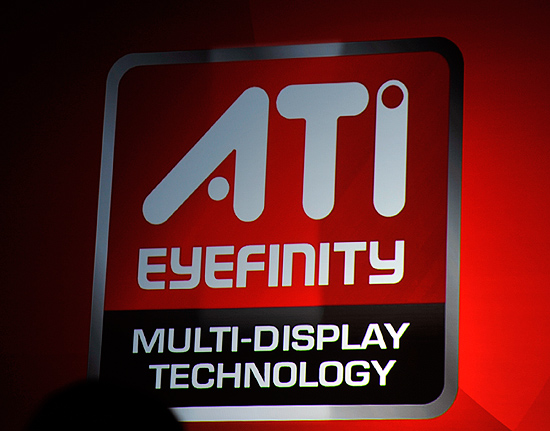
At the bare minimum, the lowest end AMD DX11 GPU can support up to 3 displays. At the high end? A single GPU will be able to drive up to 6 displays.

AMD's software makes the displays appear as one. This will work in Vista, Windows 7 as well as Linux.
The software layer makes it all seamless. The displays appear independent until you turn on SLS mode (Single Large Surface). When on, they'll appear to Windows and its applications as one large, high resolution display. There's no multimonitor mess to deal with, it just works. This is the way to do multi-monitor, both for work and games.
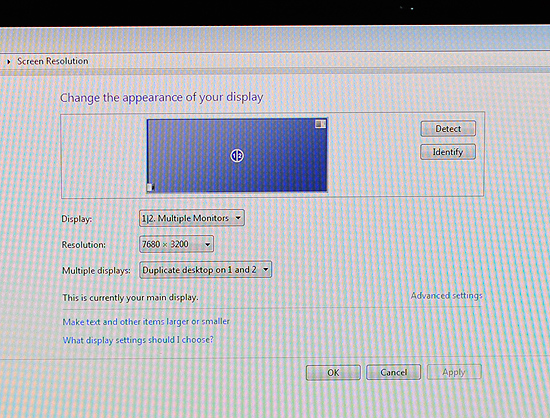
Note the desktop resolution of the 3x2 display setup
I played Dirt 2, a DX11 title at 7680 x 3200 and saw definitely playable frame rates. I played Left 4 Dead and the experience was much better. Obviously this new GPU is powerful, although I wouldn't expect it to run everything at super high frame rates at 7680 x 3200.
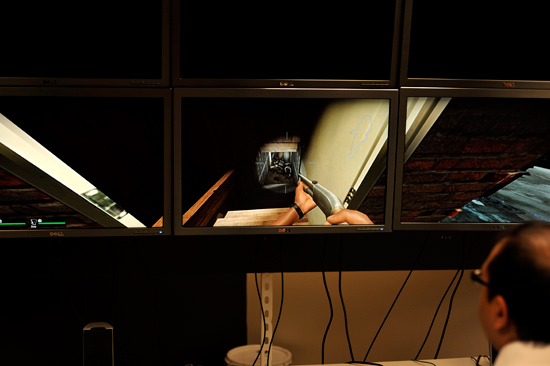
Left 4 Dead in a 3 monitor configuration, 7680 x 1600
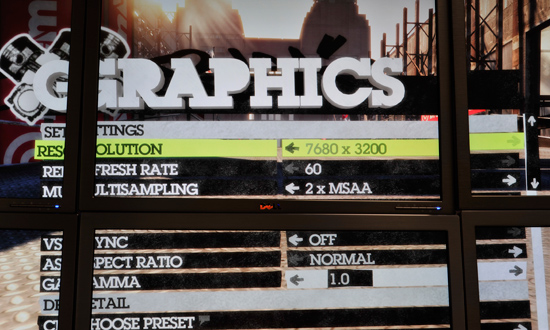
If a game pulls its resolution list from Windows, it'll work perfectly with Eyefinity.
With six 30" panels you're looking at several thousand dollars worth of displays. That was never the ultimate intention of Eyefinity, despite its overwhelming sweetness. Instead the idea was to provide gamers (and others in need of a single, high resolution display) the ability to piece together a display that offered more resolution and was more immersive than anything on the market today. The idea isn't to pick up six 30" displays but perhaps add a third 20" panel to your existing setup, or buy five $150 displays to build the ultimate gaming setup. Even using 1680 x 1050 displays in a 5x1 arrangement (ideal for first person shooters apparently, since you get a nice wrap around effect) still nets you a 8400 x 1050 display. If you want more vertical real estate, switch over to a 3x2 setup and then you're at 5040 x 2100. That's more resolution for less than most high end 30" panels.
![]()
Any configuration is supported, you can even group displays together. So you could turn a set of six displays into a group of 4 and a group of 2.
It all just seems to work, which is arguably the most impressive part of it all. AMD has partnered up with at least one display manufacturer to sell displays with thinner bezels and without distracting LEDs on the front:
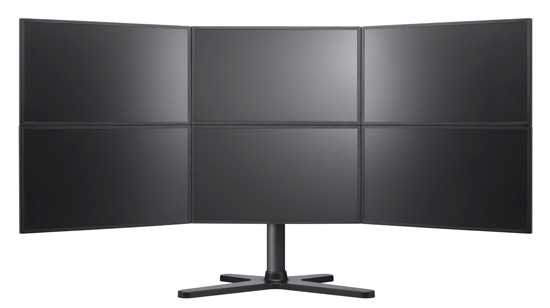
A render of what the Samsung Eyefinity optimized displays will look like
We can expect brackets and support from more monitor makers in the future. Building a wall of displays isn't exactly easy.










137 Comments
View All Comments
SkullOne - Thursday, September 10, 2009 - link
That is true but you're not seeing the big picture and yes that pun was intentional.Current monitors strapped together like in the demo are worthless for things like L4D or Counter-Strike. But what about future monitors? I can see vendors building a single giant monitor built from 3 or 6 or more monitors and making them a more or less seamless and market those to the extremely hardcore gamer.
Visual - Friday, September 11, 2009 - link
Ok, but then why not just have it be one monitor to begin with?One whole panel will always be better than pieces strapped together even if they are without bezels. One single video port and cable, even if it is "six-link displayport" or some other freaky name will be better than multiple cables.
Penti - Sunday, September 13, 2009 - link
For games yes it's useless, but have you ever seen the gigapixel projects (and the displays for viewing very high resolution images) universities do? This will simplify it brutally, before they had a PC for every screen or two and rendered with software. Now they can just connect them to a single desktop if 6 displays is all they need, or when running with software rendering cut down the number of PCs by a factor of 3. When you need high resolution you can't just use one big display (or projector) because the resolution will be to low for that stuff.On the other hand, this is just for displaying the multi-monitor capabilities and people use more then one monitor in the real world, maybe not as one giant screen (they do that too of course) but that's not the point that is just one of the mode you can use. And for those who use that mode it's now greatly simplified, before it was a hell getting acceleration and stuff working across both screens at the same time or stretch some apps across the two screens, this is now no problem as it's just one single surface for windows and the applications. But as said you simply can't build a single display with a resolution of say 11520 x 6480.
Havor - Saturday, September 12, 2009 - link
[quote]One single video port and cable, even if it is "six-link displayport" or some other freaky name will be better than multiple cables. [/quote]Is there a problem i don't see ?
Its the same as whit RGB cables you have 3 of them together and only the ends fan out.
Not seeing the problem here
Ratinator - Friday, September 11, 2009 - link
How many monitors have you seen that can do a 10240 x 3200 display? I think that was part of the points of this demo as well is the throughput of the card. Techology ain't there yet. This is where the flexible panels of the future will shine.Ratinator - Friday, September 11, 2009 - link
Meant 7680x3200slowside - Friday, September 11, 2009 - link
Cost & manufacturing complexity. It is much much easier & cheaper for them to build smaller displays. So it is much cheaper, and easier for them the put 3 small displays in one package than make one huge panel with the same resolution.gamara - Friday, September 11, 2009 - link
And having 6 panels strapped together makes 6 points of failure. Any one of the panels has bad pixels or an other bad component and you will have a mess. Replacing one will probably lead to temperature differences and right next to each other that type of issue will show. I agree that it would need panels without bezels to work right for gaming. It would be annoying as a desktop too. Can you imaging trying to use IE or Firefox with lines in the middle of your web pages?moriz - Sunday, September 20, 2009 - link
and having one giant panel makes 1 point of failure. if you have a problem, you replace the whole thing. this is MUCH more costly than replacing one panel out of six. indeed, it's probably more costly than replacing all six panels all together.the technology for such a display has been around for at least a year, if not longer. i recall seeing a three panel display at a tech conference (can't remember which), where a high end computer was driving crysis on all three displays.
JonnyDough - Monday, September 14, 2009 - link
I see it as a good thing. Panels have an advantage of "if one goes bad replace it" as opposed to a giant monitor that gets a bad pixel and is irreplaceable due to cost. $150 and I'm good as new. With a $12K monitor, I imagine I'd just keep using it with a few bad pixels in it.